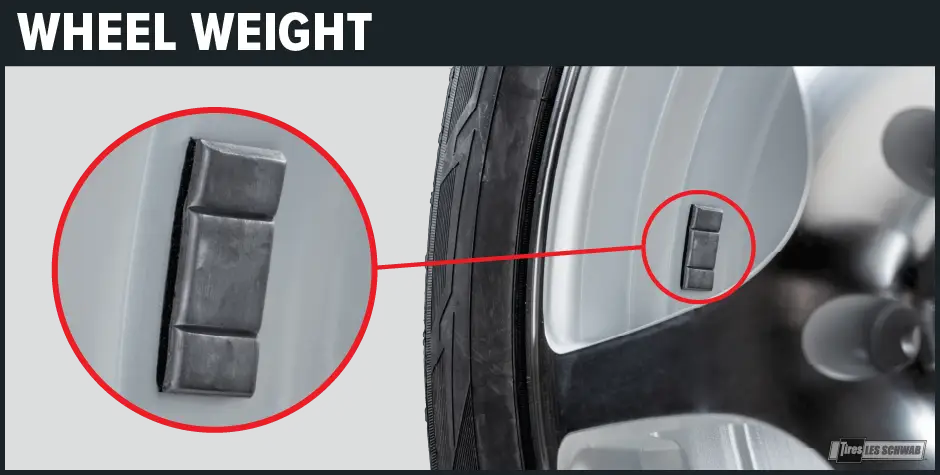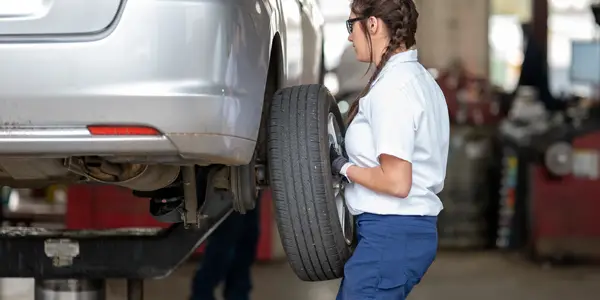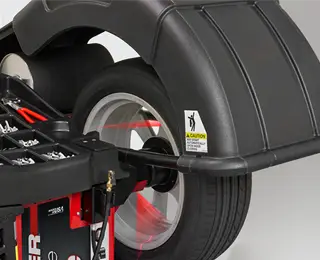How Do I Know If My Tires Need to Be Balanced?
No two tires or wheels are ever the exact same. That includes the overall tire weight and wheel weight. Those small differences, when left unresolved, can push your vehicle out of alignment. They can also cause vibrations in your steering wheel and a reduction in driving performance. Let’s take a look at tire balancing, why it’s different from an alignment, and how properly balanced tires last longer and help you get more miles per gallon or charge.
What’s the Difference Between Tire Balancing and Alignment?
Tire balancing is the act of adding weights to your wheels to ensure all parts of your tire and wheel assembly are evenly weighted around the center. This helps minimize tire wobbling and vibrations, improves tire wear, and can help maximize fuel and range efficiency. An alignment adjusts the angles of your tires to each other to ensure proper contact with the road for safety, improved handling, and a boost in miles per gallon or miles per watt.
Tire balancing and rotations can be done at the same time. However, they aren’t the same service. A tire rotation is done when a vehicle’s front and rear wheels are switched to even out tread wear. Since both require removing each wheel, it’s convenient to do them at the same time.
What Is a Tire Balance?
Tire balancing, using small weights, is a tune-up for each of your wheel and tire assemblies. These small bits of metal help ensure weight is evenly distributed around the entire circumference of the tire and wheel.
What is an Alignment?
An alignment is the process of adjusting the angles of your vehicle’s wheels so they are all working together on straightaways and corners. Everyday driving can cause your wheels to get slightly out of sync from one another. That can be especially true if you hit a few curbs or potholes.
When one or more of your wheels isn’t pointing in the same direction, your tires are essentially skidding ever so slightly. This can lead to faster tire wear, pulling to one side or the other, a steering wheel that’s off-center, and loss of fuel or range economy.
If possible, get your alignment checked once or twice a year. See our article When to Get Your Car Alignment Checked for more.
Why Balance Your Tires and Wheels?
The common symptoms of an out-of-balance wheel and tire assembly are uneven and faster tread wear, poor fuel/range economy, or vibration in the steering wheel and/or floorboard that gets worse at faster speeds. When all areas of the wheel and tire assembly are as equal in weight as possible, the tire will roll smoothly. This helps improve tread wear. Balancing also contributes to overall ride comfort.
Imbalanced tires can wobble or hop up and down, causing vibration. If a front tire isn’t properly balanced, you’ll likely feel vibrations in the steering wheel. If the problem is in the rear, you’ll feel shaking in the seat or floor.
How Do Wheels Get Out of Balance?
Everyday driving can cause an imbalance. If you hit a curb or pothole, the wheel weights can come off. Additionally, getting a flat can send your wheel-tire assembly out of balance.
Signs Your Tires Need Rebalancing
When a wheel and tire assembly is especially out-of-balance, you’ll likely know it right away. You’ll feel it in the steering wheel or floorboards. A thump-thump-thump sound that gets louder at lower or higher speeds might also be an indicator. Here are a few signs that you should get yours rebalanced.
Your Vehicle Pulls to One Side:
You might need an alignment, or your tires and wheels are out of balance. Les Schwab has the expertise to check your vehicle, make recommendations, and get you back on the road.
Uneven or Fast Tread Wear:
If the tread on your tires appears to wear too quickly, it could be an out-of-balance wheel-tire assembly.
Shaking Steering Wheel:
Vibration in the steering wheel when driving could be caused by an out-of-balance wheel-tire assembly, or aftermarket wheels that require hub-centric rings (used to ensure a proper fit for many different types of vehicles). It could also be a bent wheel, a damaged tire (which won’t be fixed by balancing), worn suspension parts or other aging components. If you feel a vibration, don’t wait. Get to Les Schwab and let our professionals take a look.
How Often Should Tire Balancing Be Done?
It can be a good idea to get your wheel and tire assemblies balanced with every tire rotation. Additionally, anytime you get new tires, balancing should be part of the process. Other times to consider rebalancing include when you hit a curb, pothole, or other debris that breaks off or damages a balance weight, if you get a flat repaired, or anytime you notice uneven tread wear and vibrations.
Les Schwab Tip: Do you leave your car or truck parked in one spot for months at a time? Flat spots could develop in the tires, causing balance issues. This can go away after a few miles of driving. But if not, stop by Les Schwab.
How Tires Are Rebalanced
Rebalancing is done in a tire shop by putting the wheel and tire assembly on a tire balancing machine. This machine takes measurements to pinpoint lighter or heavier areas. Adjustments are then made to account for these weight differences. The best time to get it done is when tires are being rotated or your vehicle is getting an alignment, both for convenience and because you might have a tire out of balance on the rear of the vehicle and won’t feel it until it is moved to the front.
Here’s how it’s done:
- A tire mounted on a wheel is attached to a tire balancing machine.
- The wheel is spun while vibration measurements are taken. This tells the tech if the weight is spread evenly, how much weight to add and where on the wheel to attach it.
- If an imbalance is found, the technician may be able to rebalance and adjust the weights (adding more). But sometimes it requires the tech to also reposition the tire on the wheel and then rebalance. This is because a heavy spot on the wheel and on the tire can sometimes line up together, causing a greater imbalance that needs to be corrected.

How Does Balancing Benefit Your Car?
Though both should be part of regular auto maintenance, balancing isn’t the same as getting an alignment. Wheel alignment corrects the angles of the tires so they travel in the same direction and properly make contact with the road. An alignment reduces uneven tire wear and extends the life of your tires.
The benefits of a balanced wheel and tire assembly include a smoother ride, as well as money-saving benefits such as less tread wear, better gas mileage or range, and less strain on many parts of your vehicle.
Les Schwab Tire Rebalancing & Alignment Services
Properly balanced wheel and tire assemblies can save you a lot of money. Les Schwab has the tools and know-how to get yours done right. If you have a set of Les Schwab tires, come on by and we’ll rebalance them for free. It’s part of the Les Schwab Tire Warranty. Didn’t buy your tires here? We’ll be happy to take a look, give you an estimate, and get the job done right.
What you need to know

Tire Rotations: What You Need to Know
Discover the benefits of tire rotations at Les Schwab to extend tire life and improve performance. Schedule your tire rotation today!

Guide to Dual Wheel Trucks (Dually) Maintenance
Recommended Meta Description Learn how to maintain your dual-wheel truck and save money with tips from Les Schwab, the trusted choice for heavy-duty truck and trailer tire services.

General FAQ
Find quick answers to your questions about store hours, tire products, vehicle services, pricing, warranties, and more on our Les Schwab General FAQ page.

